Yanhong Zeng
Multi-identity Human Image Animation with Structural Video Diffusion
Apr 05, 2025Abstract:Generating human videos from a single image while ensuring high visual quality and precise control is a challenging task, especially in complex scenarios involving multiple individuals and interactions with objects. Existing methods, while effective for single-human cases, often fail to handle the intricacies of multi-identity interactions because they struggle to associate the correct pairs of human appearance and pose condition and model the distribution of 3D-aware dynamics. To address these limitations, we present Structural Video Diffusion, a novel framework designed for generating realistic multi-human videos. Our approach introduces two core innovations: identity-specific embeddings to maintain consistent appearances across individuals and a structural learning mechanism that incorporates depth and surface-normal cues to model human-object interactions. Additionally, we expand existing human video dataset with 25K new videos featuring diverse multi-human and object interaction scenarios, providing a robust foundation for training. Experimental results demonstrate that Structural Video Diffusion achieves superior performance in generating lifelike, coherent videos for multiple subjects with dynamic and rich interactions, advancing the state of human-centric video generation.
LEGO-Puzzles: How Good Are MLLMs at Multi-Step Spatial Reasoning?
Mar 25, 2025Abstract:Multi-step spatial reasoning entails understanding and reasoning about spatial relationships across multiple sequential steps, which is crucial for tackling complex real-world applications, such as robotic manipulation, autonomous navigation, and automated assembly. To assess how well current Multimodal Large Language Models (MLLMs) have acquired this fundamental capability, we introduce \textbf{LEGO-Puzzles}, a scalable benchmark designed to evaluate both \textbf{spatial understanding} and \textbf{sequential reasoning} in MLLMs through LEGO-based tasks. LEGO-Puzzles consists of 1,100 carefully curated visual question-answering (VQA) samples spanning 11 distinct tasks, ranging from basic spatial understanding to complex multi-step reasoning. Based on LEGO-Puzzles, we conduct a comprehensive evaluation of state-of-the-art MLLMs and uncover significant limitations in their spatial reasoning capabilities: even the most powerful MLLMs can answer only about half of the test cases, whereas human participants achieve over 90\% accuracy. In addition to VQA tasks, we evaluate MLLMs' abilities to generate LEGO images following assembly illustrations. Our experiments show that only Gemini-2.0-Flash and GPT-4o exhibit a limited ability to follow these instructions, while other MLLMs either replicate the input image or generate completely irrelevant outputs. Overall, LEGO-Puzzles exposes critical deficiencies in existing MLLMs' spatial understanding and sequential reasoning capabilities, and underscores the need for further advancements in multimodal spatial reasoning.
DiffSensei: Bridging Multi-Modal LLMs and Diffusion Models for Customized Manga Generation
Dec 10, 2024
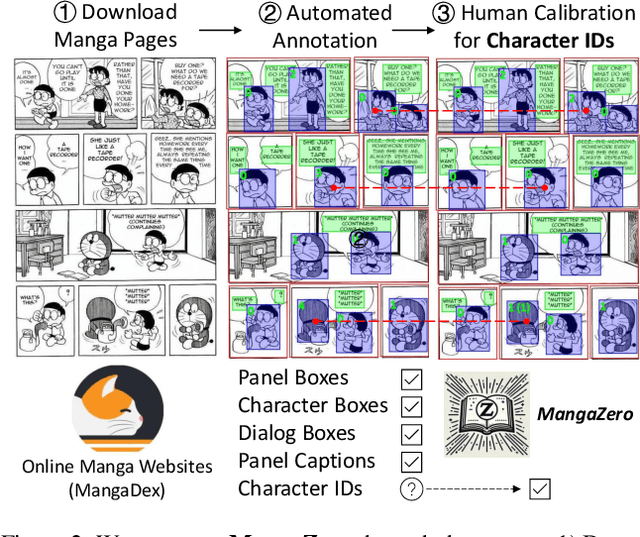
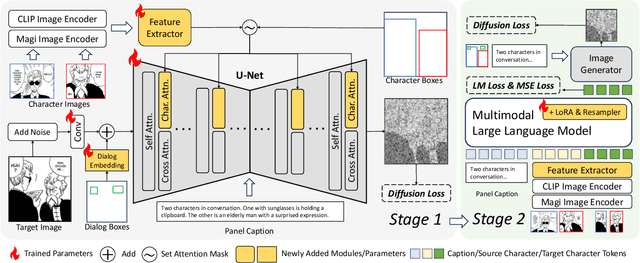

Abstract:Story visualization, the task of creating visual narratives from textual descriptions, has seen progress with text-to-image generation models. However, these models often lack effective control over character appearances and interactions, particularly in multi-character scenes. To address these limitations, we propose a new task: \textbf{customized manga generation} and introduce \textbf{DiffSensei}, an innovative framework specifically designed for generating manga with dynamic multi-character control. DiffSensei integrates a diffusion-based image generator with a multimodal large language model (MLLM) that acts as a text-compatible identity adapter. Our approach employs masked cross-attention to seamlessly incorporate character features, enabling precise layout control without direct pixel transfer. Additionally, the MLLM-based adapter adjusts character features to align with panel-specific text cues, allowing flexible adjustments in character expressions, poses, and actions. We also introduce \textbf{MangaZero}, a large-scale dataset tailored to this task, containing 43,264 manga pages and 427,147 annotated panels, supporting the visualization of varied character interactions and movements across sequential frames. Extensive experiments demonstrate that DiffSensei outperforms existing models, marking a significant advancement in manga generation by enabling text-adaptable character customization. The project page is https://jianzongwu.github.io/projects/diffsensei/.
HumanVid: Demystifying Training Data for Camera-controllable Human Image Animation
Jul 28, 2024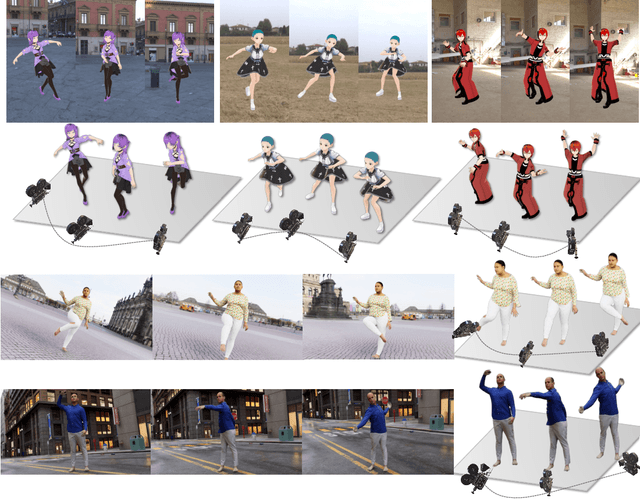

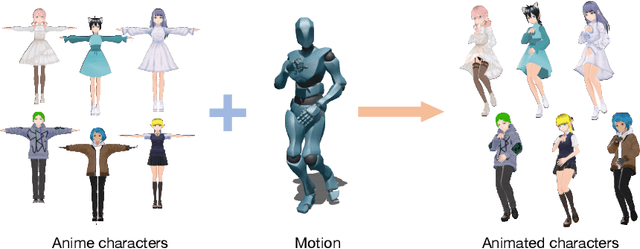
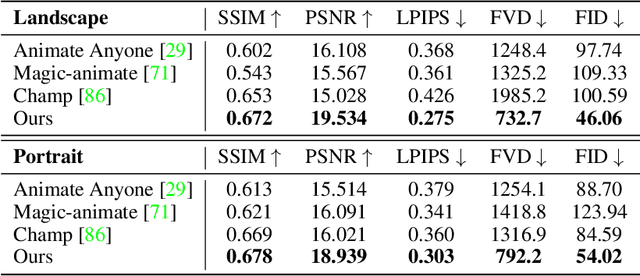
Abstract:Human image animation involves generating videos from a character photo, allowing user control and unlocking potential for video and movie production. While recent approaches yield impressive results using high-quality training data, the inaccessibility of these datasets hampers fair and transparent benchmarking. Moreover, these approaches prioritize 2D human motion and overlook the significance of camera motions in videos, leading to limited control and unstable video generation. To demystify the training data, we present HumanVid, the first large-scale high-quality dataset tailored for human image animation, which combines crafted real-world and synthetic data. For the real-world data, we compile a vast collection of copyright-free real-world videos from the internet. Through a carefully designed rule-based filtering strategy, we ensure the inclusion of high-quality videos, resulting in a collection of 20K human-centric videos in 1080P resolution. Human and camera motion annotation is accomplished using a 2D pose estimator and a SLAM-based method. For the synthetic data, we gather 2,300 copyright-free 3D avatar assets to augment existing available 3D assets. Notably, we introduce a rule-based camera trajectory generation method, enabling the synthetic pipeline to incorporate diverse and precise camera motion annotation, which can rarely be found in real-world data. To verify the effectiveness of HumanVid, we establish a baseline model named CamAnimate, short for Camera-controllable Human Animation, that considers both human and camera motions as conditions. Through extensive experimentation, we demonstrate that such simple baseline training on our HumanVid achieves state-of-the-art performance in controlling both human pose and camera motions, setting a new benchmark. Code and data will be publicly available at https://github.com/zhenzhiwang/HumanVid/.
Live2Diff: Live Stream Translation via Uni-directional Attention in Video Diffusion Models
Jul 11, 2024Abstract:Large Language Models have shown remarkable efficacy in generating streaming data such as text and audio, thanks to their temporally uni-directional attention mechanism, which models correlations between the current token and previous tokens. However, video streaming remains much less explored, despite a growing need for live video processing. State-of-the-art video diffusion models leverage bi-directional temporal attention to model the correlations between the current frame and all the surrounding (i.e. including future) frames, which hinders them from processing streaming videos. To address this problem, we present Live2Diff, the first attempt at designing a video diffusion model with uni-directional temporal attention, specifically targeting live streaming video translation. Compared to previous works, our approach ensures temporal consistency and smoothness by correlating the current frame with its predecessors and a few initial warmup frames, without any future frames. Additionally, we use a highly efficient denoising scheme featuring a KV-cache mechanism and pipelining, to facilitate streaming video translation at interactive framerates. Extensive experiments demonstrate the effectiveness of the proposed attention mechanism and pipeline, outperforming previous methods in terms of temporal smoothness and/or efficiency.
FoleyCrafter: Bring Silent Videos to Life with Lifelike and Synchronized Sounds
Jul 01, 2024
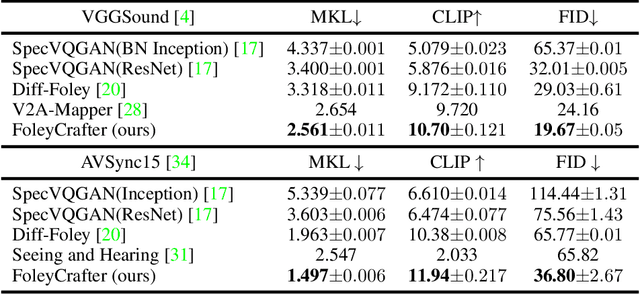
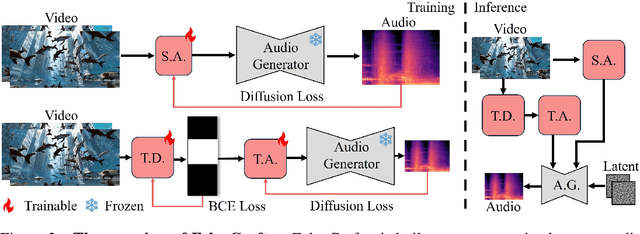

Abstract:We study Neural Foley, the automatic generation of high-quality sound effects synchronizing with videos, enabling an immersive audio-visual experience. Despite its wide range of applications, existing approaches encounter limitations when it comes to simultaneously synthesizing high-quality and video-aligned (i.e.,, semantic relevant and temporal synchronized) sounds. To overcome these limitations, we propose FoleyCrafter, a novel framework that leverages a pre-trained text-to-audio model to ensure high-quality audio generation. FoleyCrafter comprises two key components: the semantic adapter for semantic alignment and the temporal controller for precise audio-video synchronization. The semantic adapter utilizes parallel cross-attention layers to condition audio generation on video features, producing realistic sound effects that are semantically relevant to the visual content. Meanwhile, the temporal controller incorporates an onset detector and a timestampbased adapter to achieve precise audio-video alignment. One notable advantage of FoleyCrafter is its compatibility with text prompts, enabling the use of text descriptions to achieve controllable and diverse video-to-audio generation according to user intents. We conduct extensive quantitative and qualitative experiments on standard benchmarks to verify the effectiveness of FoleyCrafter. Models and codes are available at https://github.com/open-mmlab/FoleyCrafter.
StyleShot: A Snapshot on Any Style
Jul 01, 2024Abstract:In this paper, we show that, a good style representation is crucial and sufficient for generalized style transfer without test-time tuning. We achieve this through constructing a style-aware encoder and a well-organized style dataset called StyleGallery. With dedicated design for style learning, this style-aware encoder is trained to extract expressive style representation with decoupling training strategy, and StyleGallery enables the generalization ability. We further employ a content-fusion encoder to enhance image-driven style transfer. We highlight that, our approach, named StyleShot, is simple yet effective in mimicking various desired styles, i.e., 3D, flat, abstract or even fine-grained styles, without test-time tuning. Rigorous experiments validate that, StyleShot achieves superior performance across a wide range of styles compared to existing state-of-the-art methods. The project page is available at: https://styleshot.github.io/.
Auto Cherry-Picker: Learning from High-quality Generative Data Driven by Language
Jun 28, 2024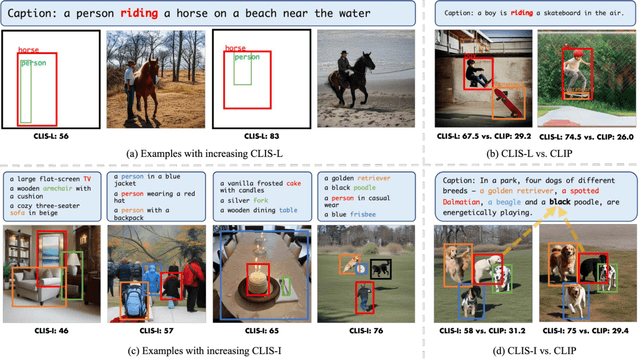



Abstract:Diffusion-based models have shown great potential in generating high-quality images with various layouts, which can benefit downstream perception tasks. However, a fully automatic layout generation driven only by language and a suitable metric for measuring multiple generated instances has not been well explored. In this work, we present Auto Cherry-Picker (ACP), a novel framework that generates high-quality multi-modal training examples to augment perception and multi-modal training. Starting with a simple list of natural language concepts, we prompt large language models (LLMs) to generate a detailed description and design reasonable layouts. Next, we use an off-the-shelf text-to-image model to generate multiple images. Then, the generated data are refined using a comprehensively designed metric to ensure quality. In particular, we present a new metric, Composite Layout and Image Score (CLIS), to evaluate the generated images fairly. Our synthetic high-quality examples boost performance in various scenarios by customizing the initial concept list, especially in addressing challenges associated with long-tailed distribution and imbalanced datasets. Experiment results on downstream tasks demonstrate that Auto Cherry-Picker can significantly improve the performance of existing models. In addition, we have thoroughly investigated the correlation between CLIS and performance gains in downstream tasks, and we find that a better CLIS score results in better performance. This finding shows the potential for evaluation metrics as the role for various visual perception and MLLM tasks. Code will be available.
MotionBooth: Motion-Aware Customized Text-to-Video Generation
Jun 25, 2024Abstract:In this work, we present MotionBooth, an innovative framework designed for animating customized subjects with precise control over both object and camera movements. By leveraging a few images of a specific object, we efficiently fine-tune a text-to-video model to capture the object's shape and attributes accurately. Our approach presents subject region loss and video preservation loss to enhance the subject's learning performance, along with a subject token cross-attention loss to integrate the customized subject with motion control signals. Additionally, we propose training-free techniques for managing subject and camera motions during inference. In particular, we utilize cross-attention map manipulation to govern subject motion and introduce a novel latent shift module for camera movement control as well. MotionBooth excels in preserving the appearance of subjects while simultaneously controlling the motions in generated videos. Extensive quantitative and qualitative evaluations demonstrate the superiority and effectiveness of our method. Our project page is at https://jianzongwu.github.io/projects/motionbooth
Sagiri: Low Dynamic Range Image Enhancement with Generative Diffusion Prior
Jun 13, 2024Abstract:Capturing High Dynamic Range (HDR) scenery using 8-bit cameras often suffers from over-/underexposure, loss of fine details due to low bit-depth compression, skewed color distributions, and strong noise in dark areas. Traditional LDR image enhancement methods primarily focus on color mapping, which enhances the visual representation by expanding the image's color range and adjusting the brightness. However, these approaches fail to effectively restore content in dynamic range extremes, which are regions with pixel values close to 0 or 255. To address the full scope of challenges in HDR imaging and surpass the limitations of current models, we propose a novel two-stage approach. The first stage maps the color and brightness to an appropriate range while keeping the existing details, and the second stage utilizes a diffusion prior to generate content in dynamic range extremes lost during capture. This generative refinement module can also be used as a plug-and-play module to enhance and complement existing LDR enhancement models. The proposed method markedly improves the quality and details of LDR images, demonstrating superior performance through rigorous experimental validation. The project page is at https://sagiri0208.github.io
 Add to Chrome
Add to Chrome Add to Firefox
Add to Firefox Add to Edge
Add to Edge